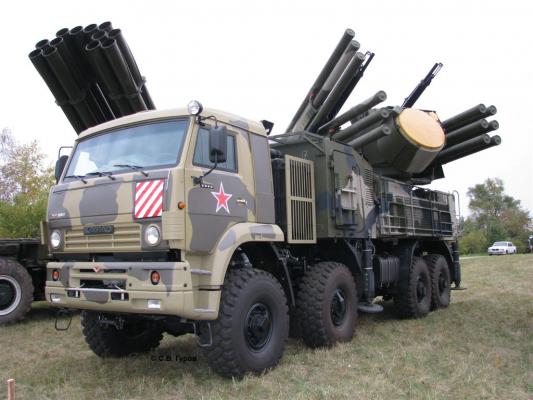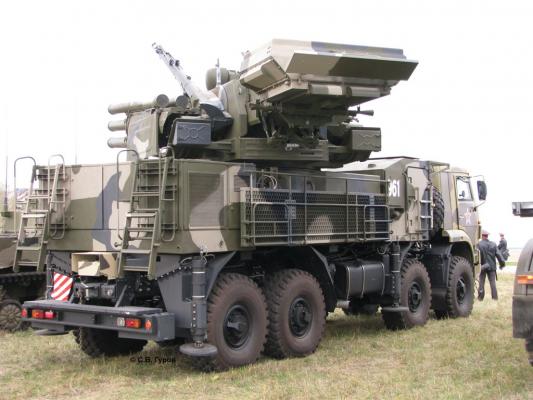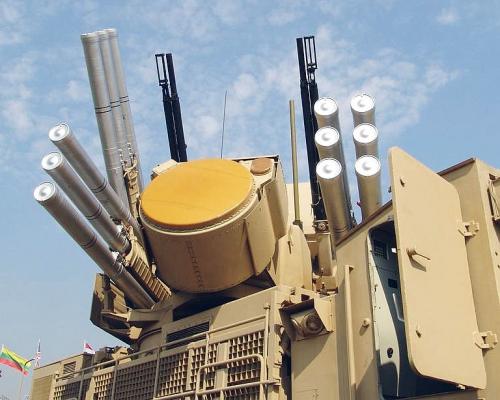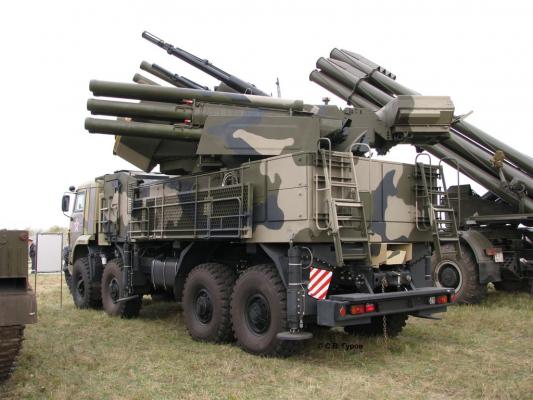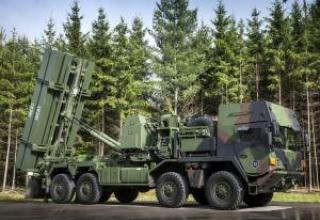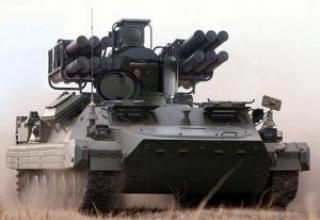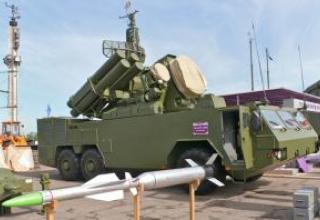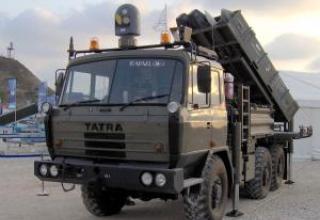Universal anti-aircraft missile and gun system (AAGC) of close action "Panzer-C1" is designed for air defense of the most important small and point military and industrial facilities, units and for strengthening air defense groups at low and extremely low altitudes from massive strikes of air attack means with the use of high-precision weapons.
The complex was developed at the State Unitary Enterprise "Instrument Engineering Design Bureau" (State Unitary Enterprise "KBP", Tula, now JSC "Instrument Engineering Design Bureau" named after A. G. Shipunov). The development of a promising complex "Panzer" for the Air Defense Forces was set by the KBP in 1990. "The "Pancir" (see photo) was a natural development of the Tunguska SAM system adopted for service in 1982. Since the Tunguska was adopted for service, its technical characteristics have changed significantly. There appeared cruise missiles (cruise missiles), flying at low altitudes and providing high accuracy of hit, remotely manned aircraft (UAV), which have an extremely small signature in all radiation ranges. Flight speeds of some types of targets have increased to 1000 m/s. The Tunguska MLRS missile weaponry proved to be ineffective in combating new threats.
In 1994, the instrumentation design bureau created a prototype of a combat vehicle complex "Panzer", which was tested and demonstrated in August 1995 at the Air Show in Zhukovsky. As the landing gear was used a cross-country vehicle with wheel arrangement 8x8 "Ural" -5323.4. However, by this time due to the economic crisis funding for the development of the complex virtually stopped. Only in the second half of the 90's did "Pantsir" returned to continue working on the MRIC. On May 24, 2000 it was announced the conclusion of the contract worth $734 million for the supply of three batches of 50 complexes "Pantsir-C1" to the United Arab Emirates within three years.
The establishment of the complex, despite a number of technical and organizational difficulties, was generally successful. A long-range missile was created, the 2A72 gun was replaced by the 2A38M double-barreled high-speed 30-mm anti-aircraft guns, the main subsystems and elements of the complex were developed, including target detection radars. One problem remained - the creation of a target and anti-aircraft missile tracking station (TMSS). Initially, JSC "Fazatron-NIIR" created a dual-band multi-purpose 1L36 "Roman" radar (1995, see photo) for the control system of ground-based and ship-based SAMs, including the first version of the "Panzer" SAM system. In 2005 a new 1RS2-E station was developed for use in the complex together with JSC "RATEP". But both stations were found unsuccessful by the developers of "Pantsir-C1".
Due to the current situation, in 2005 the new station was developed in cooperation with JSC "RATEP". KBP proposed the project of practically new complex, which development took more time. According to the new deadlines agreed with the customer, the first complexes were planned to be handed over to the UAE Armed Forces in 2006. A new multifunctional escort locator with a phased antenna array of mm-range was to be installed at the "2006 model" complex. This improvement allowed for a significant improvement in the performance of the complex. Thus, the number of simultaneously hit targets was brought from 2 to 4. The target acquisition area has been increased to 20 km in range and 15 km in height, and high resistance to radio countermeasures has been ensured. The installation of the complex on a tracked (Belarusian-made GM352M1E) or a number of wheeled chassis (MZKT-7930, KamAZ-6350, etc.), as well as the placement on the decks of surface ships and as a stationary protected air defense facility. In the course of the works as an intermediate variant of the complex the single-channel target fighting vehicle "Panzer-C1-0" was created. (ZOY6). It allowed to fight the air enemy in the 1.5-18 km range using eight missiles pointed at the target only by the optical channel. Unlike the basic version, the Pantsir-C1-0 anti-aircraft missile system was originally designed for various non-specialized wheeled or tracked chassis, such as the Kamaz, APC and BMP (with a dismantled turret). This presupposes the possibility of operative modification of the vehicles available to a potential customer into combat vehicles of the Panzer-C1-0 system.
Production of the main elements of the complex is launched at JSC "AK Tulamashzavod", JSC "KEMZ". Radar station 1RS1-1E of dm-range target detection was created in VNIIRT. The automated complex of communication facilities designed to provide data exchange between combat vehicles was created jointly by the Voronezh Research Institute of Communication and the "Constellation" concern. The data transmission facilities were developed in CJSC "Center of Fiber Optical Information Transmission Systems". The thermal imaging channel of the optical guidance subsystem of the complex was developed at the NPO "State Institute of Applied Optics".
In the middle of 2006 the Pantsir-C1 MRSC passed successful tests with missile launches at Kapustin Yar Range. In 2010 the complex was adopted for service. At the same time the geography of "Panzer-C1" complexes export was expanding - a contract with Syria and Algeria was concluded.
In 2011, a version of "Panzer-C1" (see photo), equipped with a new radar target detection station "S"-range, which is more effective also in conditions of active and passive interference, was put on trial. This version has been developed by the specialists of the Design Bureau of Instrument Engineering, Tula, and the Central Design Bureau of Instrument Engineering, Tula.
Composition:
The military facilities of the complex include:
- combat vehicle (up to 6 BM in battery);
- anti-aircraft guided missile;
- 30mm shot;
- vehicle charger (one vehicle for 2 BM)
Maintenance facilities:
- maintenance machine (for maintenance and repair of mechanical components);
- a repair and maintenance machine (for the maintenance and repair of electronic components and units);
- alignment machine;
- ZIP machine (for transportation of group set ZIP).
The training facilities included in the complex are intended for teaching and training the BM calculations to the basic methods of combat work and maintenance. They are represented by class 9F676-1 and mobile 9F676-2 versions of simulators.
The LM is designed to perform the tasks assigned to the complex to hit a wide range of aerodynamic and ground targets, including light armored vehicles and enemy live force. The LM has a modular design that includes: a control module with a calculation, weapons module, tower installation and a power supply system compartment (EPS). The modular principle of construction allows to create a complex in various configurations and placement on various transport bases, as well as stationary design. The complex can be placed on light armored vehicles and used as a powerful mobile air defense vehicle in airborne troops, as well as on wheeled and tracked bases in air defense and air defense forces and naval ships (see photo 1, photo 2, photo 3, photo 4). The special feature of the armament of the Panzer-C1 complex is the presence in one combat unit of combined missile and gun weapons, detection and escort means, united by a single multi-band control system. The control system (see the functional diagram) of the complex has a high resistance to interference of any type due to the combination of radar and optical-electronic means in a single system operating in dm-, sm-, mm- and IR wavelength ranges.
The tower unit consists of 2 blocks of 6 anti-aircraft missiles, 2 cannons placed on the inner side of the launching containers of SAM, and a control system. The 9M335/57E6 surface-to-air missile (see Figure 1, Figure 2) (export designation 57E6-E) is similar in appearance and layout to the 9M311 Tunguska SAM system (see description, 9M311 projections). The missile's casing is bicaliber, and the launch engine is in a separable stage. The missile has a high speed (1300m/c) and low flight time (2c) at the launch site. After separation of the starting engine, the rocket has high maneuverability and a small ballistic deceleration (speed reduction by 40 m/s on 1 km). The kill zone is 20 km in range and 15 km in height. The weight of the combat unit with rods of attacking elements is 20 kg. Fuses - contact and radar adaptive non-contact (trigger radius up to 9m). The missile uses an air-dynamic steering gear. Missile guidance system - radio command.
The cannon armament includes two 2A38M double-barreled anti-aircraft guns (see Photo 1 and Photo 2), capable of engaging air and ground targets in the zone at a range of up to 4 km, at an altitude of up to 3 km.
The 2A38M assault rifle has the capability to engage air and ground targets at a range of up to 4 km and an altitude of up to 3 km (see photo 1 and photo 2):
Automatic machine 2A38M has:
- two barrels firing alternately, allowing for a high firing rate between 1950 and 2500 GPM;
- a self-contained evaporative cooling system for the barrels, allowing the use of drinking water with little consumption;
- induction sensor of the initial velocity of the projectile, which increases the accuracy of the rifle firing as part of the anti-aircraft system;
- front position sensor, which signals the readiness of the rifle for firing (position of the moving parts of the rifle) and a counter of the remaining cartridges;
- a pyrotechnic reloading system with three pyrotechnic cartridges, which allows the remote elimination of "misfire" type delays.
The Battle Mashine Information Systems (see image) of an SAM consists of a Target Detection Station (TDMS), a Target and Missile Tracking Station (TSS) and an Optical Electronic System (OES) for tracking targets and missiles.
SOCs (see Figure 1RS1) provide automatic tracking of up to twenty targets, for each of which three coordinates and the radial component of target speed are given to the BM computer system. In addition, the SOC determines the nationality of the target and identifies the type of target (aircraft, helicopter, small target), which significantly increases the probability of hitting the target.
An upgraded version of the system has been developed (see photo), equipped with SOC "S"-range (see description).
The high combat performance of Panzer-C1 is largely ensured by the use of a target and missile tracking station built using a phased array antenna (phased array). The Phased Array Program (see diagram) consists of two stations, the first of which operates only to receive the signals of the Radio Respondent (RO) of the LAS, using a small number of elements, measures three coordinates of the LAS and is used at the point where the missile enters the main radar chart. The second station with multi-element AF operates in the target and missile receiving mode. Application of the AF allows to realize three firing channels on three targets in radar, all-weather mode, and on one of the most dangerous targets can be provided by multiple firing of two missiles. In addition, the SLCM provides radar input of the missiles by means of AF from the scattering area formed at the initial uncontrolled section of the missile's flight to the zone where the missile is captured by a channel for precise guidance of the main AF. The use of radar input has significantly improved the flight and ballistic characteristics of the missile by using high-energy blended fuel in a detachable launch accelerator. Simultaneously with target tracking by angular coordinates and range, the SRC measures three missile coordinates (two angles and range) by the signals of the missile's radio responder (RO) and transmits remote control commands to the missile. The SRCS of the complex operates in the short-wave range of radio waves, which provides high accuracy of angular coordinates measurement and the ability to work in radar mode on targets flying at low altitude.
Optronic system (OES) of target and missile tracking is used for firing at ground targets and targets flying at extremely low altitudes. The ECS (see the scheme) is located at the Autonomous Optical Post (AOP), which allows to direct the ECS optical axes along the signals of the Central Computing System (CPC) to the target in the range of angles: azimuth - 90°, angle of position - from - 5° to + 82°. ECO allows to search for a target on the basis of target designation data from the Central Computing System and to automatically capture a target for auto tracking. Target tracking is performed in the infrared range of 3-5 microns, which provides all-day use of missile weapons in optical mode. The range of car support (with a range of 10 km) is: aircraft F-16 - 17-26km; PRR HARM - 13-15km; CR ALCM - 11-14km. Visualization of SAM is carried out in the near infrared spectral range (0.8 microns), the march stage of the missile is visualized by the pulse signals of the optical sensor of SAM, which provides high noise immunity of the channel from false thermal targets. Narrow fields of view of optical channels and high accuracy of gearless motors of AOP guidance drives provide accuracy of measurement of angular coordinates of a target and a missile not worse than 0.05 mrad on channels of azimuth and a place angle. Systematic errors of the rocket and target channels of the AOS are eliminated during the launch of the SAM in the process of automatic mutual alignment of the direction finders of the rocket and the target. Precise measurement of missile angular deviations from the target sighting line allows implementing a highly precise system of pointing the missile at the target in the optical mode of control system operation. Only in optical mode is it possible to fire the missile at targets flying at extremely low altitudes (5 m above water surface) and at ground targets.
The features of the complex are:
- Versatility of action, i.e. ensuring the defeat of air targets, and above all, all types of high-precision weapons flying at speeds of up to 1000 m/s from different directions at angles from 0 - 10° to 60 - 70°, aircraft with a flight speed of up to 500 m/s, helicopters, UAVs, as well as ground light armored targets and enemy manpower;
- simultaneous firing of four targets flying in the +45° sector due to the application of multifunction SIRTs based on the PHAR mm-range and an independent optical channel, the ability to salvo two missiles at one target;
- Combined rocket and gun weaponry, which allows to create a continuous area of engagement and continuous firing, from the maximum range of 18-20 km to a range of 200 m within the altitudes of 5 m to 15 km;
- multi-mode adaptive radar-optical weapon control system operating in dm-, mm- and infrared wavelength ranges, which provides high immunity to interference and survivability under conditions of electronic and fire suppression with the use of radar and antiradar missiles such as HARM, as well as the reliability of combat operation of the complex;
- high combat performance due to the short reaction time (4-6s), high speed of SAM flight and the availability of a multi-channel control system operating in a wide sector, automatic tracking of up to 20 SOC targets and the issuance of target designation with accuracy, which ensures fast search and capture of SOC and EC targets for tracking;
- application of unified systems - command system for guidance of missiles with high accuracy, which made it possible to create a small-size highly maneuverable SAM system with high efficiency and low cost (with a large number of SAMs on combat vehicle - 12 pieces);
- a small-size bicalibre two-stage SAM system with a solid fuel accelerator, which provides high values of average speed, maneuverability and effectiveness in hitting all types of targets due to the high power of the shrapnel and rod warhead and high accuracy of guidance by the SAM control system in the mm- and optical wave ranges;
- firing, which doubles the depth of effect and combat capabilities of the complex on manned aviation, UAV, SCR and TKR;
- firing on the move (or from short stops) of missile weapons, which expands the combat application of the complex;
- a fully automatic mode of combat operation, both in a separate combat unit and as a part of a subdivision of several combat vehicles, which makes it possible to improve the time characteristics and reduce the psychophysical load on crew members, and the possibility of conducting combat work by crew members in a semi-automatic mode;
- autonomy of combat application due to the availability in one combat unit of detection, escort and defeat means;
Depending on the local conditions in the combat area and the combat application options, Panzer-C1 can operate in one of the following modes (see diagram):
- Autonomous combat operations
- The LM operates autonomously and provides implementation of the full cycle: search, detection, identification, selection of dangerous target, target designation, additional search, capture, escort and firing of target shotguns and missiles.
- Joint combat operations
- A 6-megapixel battery with a telecoded connection is working together. Each of the LMs implements the full cycle of the LM for its chosen targets. Each LM reports information about the selected targets to other LM batteries, which exclude it from its list of served targets.
- Operation under the control of the battery command post
- Each of the 6 BMs implements all stages of combat operations, beginning with the development of target designation. The target designation is issued from the command point-.
- Work on the "Master - Slave" principle.
- The battery runs on 6 BM, one of which is assigned as "master" and the other as "slave". The "master" BM works as a command post, and also implements the functions of a combat vehicle as in autonomous combat operations. Each of the "slave" LM takes the target designation from the "master", and otherwise works as a battery control.
Regardless of the task and control modes, the anti-aircraft battery of "Panzer-C1" complex is part of the hierarchical structure of a mixed grouping with mandatory subordination of the superior control of the grouping. Depending on the composition of the group and the task to be solved as a superior control can be the control of the anti-aircraft missile brigade (grouping), anti-aircraft missile regiment, anti-aircraft missile division of the long-range (medium) range system, RTV control.
Management of the complex with the VKP can be carried out:
- is non-automated through operational command communication (OCC);
- automated via telecode communication lines.
Non-automated control of the complex (according to the QMS) is carried out by setting a combat task by the commander of the complex in the process of preparation for combat operations, and in the course of combat operations - for the transfer of operational commands from the military-industrial complex and reports from the "leading" BM and the complex UAV. Automated control of the complex with the military-industrial complex is carried out through the exchange of information on the targets to be shelled in joint areas and the issuance of instructions or bans on the shelling, taking into account the capabilities of the communications system "Panzer-C1".
High tactical and technical characteristics of the "Panzer-C1" complex, the implementation of the adopted principles of construction and technical decisions on the main facilities of the complex, ensure its high combat efficiency to repel massive strikes of air attacks using high-precision weapons, which is not less than 90-99%.
Characteristics:
| Boyacomplect: - Zoom on launcher - gunshots |
12 1400 |
| Defeat zone, km: - by missile range - high-altitude - at a range of guns - high |
1200-20000 10-15000 200-4000 0-3000 |
| The reaction time, s | 4-6 |
| Battle count, man. | 3 |
| Maximum target speed, m/s | 1000 |
| Productivity, sharp targets/min. | 8-12 |
| 1PC1 detection and target designation station | |
| Target detection range with EPR 2m2 (Pоб=0.9; Pл.т=10-6) ,km | 36 |
| Radial velocity range of detected targets, m/s | 30-1000 |
| Field of view: - azimuth, degree. - at the corner of the seat, degree. |
360 0-60; 0-30; 40-80; 0-25 |
| Period of view of the area, s | 2; 4 |
| Number of simultaneous targets | 20 |
| SCO coordinate measurement: - on azimuth, corner min. - at the corner of the place, corner min. - at a distance of, uh... - at speed, m/s |
15 30 60 20 |
| Operating range | S |
| Target and missile escort station | |
| Work area: - azimuth, degree - at the corner of the seat, degree. |
±45 between -5 and +85 |
| Maximum target detection range, km: - EPR = 2m2 - с EPR = 0.03m2 |
24 7 |
| Additional search area by SOC target designation with probability 0.9 per 1s: - azimuth, deg - at the corner of the place, deg - at a distance of, m - at speed, m/s |
±2.5 ±2.5 ±200 ±60 |
| Accuracy of target coordinates: - azimuth, deg - around the corner, deg - at a distance of, m - at speed, m/s |
0.2 0.3 3.0 2.0 |
| Measurement range of radial velocities, m/s: - on target - for SD purposes |
10-1100 30-2100 |
| Simultaneous car escort: - targets - ZUR |
up to 3-х up to 4-х |
| Operating range | К |
| Anti-aircraft guided missile 57E6-E | |
| Weight, kg - container rockets - missiles launch - combat unit |
94 74.5 20 |
| Caliber, mm - starting stage - march step |
170 90 |
| The length of the rocket, mm | 3160 |
| Length of TPK, mm | 3200 |
| Maximum rocket speed, m/sec. | 1300 |
| Average flight speed, m/s: - at a range of 12 km - at a range of 18 km |
900 780 |
| Double-barrel automatic machine 2A38M | |
| Caliber, mm | 30 |
| Number of machines | 2 |
| Weight of projectile, kg | 0,97 |
| Initial projectile velocity, m/s | 960 |
| Rate of fire, gunshot/min. | 1950-2500 |
| Weight, kg - waterless machine - cooling water |
not more than 195 not more than 28 |
| Effort of recoil, kN. | 62 |
| Machine length, mm | 3478 |
| Switchgear and contactor supply voltage from DC, V | 24 |
| Recharge | firework and manual |
| Number of pyropatrons, pcs. | 3 |
| Shooting control | remote |
| Operating conditions, ° C | ±50 |
Testing:
In May 1996 the launches of Aster-15 SAMs on the C-22 target in the mode of active radar homing on the final section of the trajectory began. The target simulated an attack aircraft flying at a speed of 270m/s at an altitude of 1000m. In April 1997, the C-22 target simulating a subsonic anti-ship cruise missile flying at an altitude of 10m was successfully intercepted. The target was intercepted at a range of 7km.
In November 1997, at a range of 7km, the Aster-15 with an inert ballistic missile for the first time hit a target simulating a low-flying SCR. In December 1997, the first successful launches of Aster-15 missiles against real targets were made (including the MM38 "Exocet" PKR intercepted at a range of 9 km).
On December 30, 1997 the first launch of Aster-30 SAM system at real targets. At a range of 30km the missile intercepted a target C-22, flying at a speed of 900km / h at an altitude of about 11000m. During the tests, "Aster-30" reached a speed of 2880 km / h, the miss was less than 4m.
2001г. - The "Aster-15" successfully intercepted a training target simulating an aircraft flying at M=1 speed at an altitude of 100m.
During 2004, three launches of Aster-15 anti-aircraft missiles were made from Saudi Riyadh class frigates at the French test site in the Mediterranean Sea. All targets were hit by a direct hit.
October 7, 2010. The British Navy announced the first firing tests of sea-based SAMs PAAMS(S) on board the squadron of "Daring" type mine carrier pr.45. Aster-30" was launched from the destroyer "Downtless", the missile successfully hit the unmanned target "Mirak-100/5" at the Hebrides test site (west of the Scottish coast). The target flew at 400 knots and a height of over 30,000 feet.
Sources:
- "Панцирь" для страны и армии /Воздушно-космическая оборона/
- Зенитный ракетно-пушечный комплекс "ПАНЦИРЬ–С1"
- Автомат двуствольный модернизированный 2А38М /Производственное объединение "Туламашзавод"/
- Russian/Soviet Point Defence Weapons
- А.Широкорад. "Шилка" и другие отечественные зенитные самоходные установки. Бронеколлекция №2,1998
- Василин Н.Я., Гуринович А.Л. "Зенитные ракетные комплексы" .-Мн.: ООО "Попурри", 2002- 464с.
- С.В.Гуров "Ракетная техника на Куликовом поле (краткий фоторепортаж)"
- ЗРПК "Панцирь-С1" с новой СОЦ
- Зенитный ракетно-пушечный комплекс "Панцирь-С1". Рекламный разворот (КБП, г.Тула).
